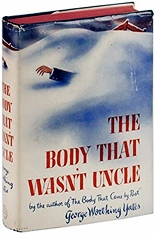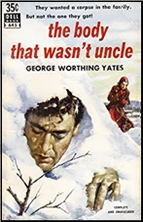Reviewed by DAVID L. VINEYARD:
GASTON LEROUX – The Phantom Clue. Macaualy, US, hardcover, 1926. Published earlier in the US as The Slave Bangle, John Long, hardcover, 1925, a translation by Hannaford Bennett of Le crime du Rouletabille (Paris, France: P. Lafitte, 1922).

Eric, the damned and haunted “hero” of The Phantom of the Opera, is Gaston Leroux’s best known creation today, thanks to numerous films and television productions and the long running Andrew Lloyd Webber musical, but in his own day and time, Leroux was as well known for his thrillers featuring the frightening facial aspect of picaresque criminal Cheri Bibi, his weird novels, and the adventures of the arrogant genius, young journalist detective Joseph Rouletabille (an influence on Herge’s teen journalist Tintin almost certainly).
If readers know of Rouletabille today it is for Leroux’s detective masterpiece, The Mystery of the Yellow Room, a famous and still effective application of the locked room mystery unraveled by the brilliant teen age sleuth (he’s only eighteen in his first case), Rouletabille.
Most lists of the classics of the genre still include this tale, Leroux’s first venture into the detective novel, and it is in print currently from Black Coat Press and before that from Dover books. In France, Rouletabille had even greater success with films, a television series, and numerous graphic albums featuring his adventures.
The Phantom Clue is the most personal of Rouletabille’s many adventures, beginning, surprisingly, with a situation closer to French farce than a mystery novel. It’s hard to imagine Philo Vance, Lord Peter, or Ellery Queen in quite such a predicament:
Rouletabille has invited his friend Maitre Sainclair (in France lawyers are addressed by the title maitre), an older friend dating back to his first adventure, to join him and his wife Ivana at the seaside in Deauville at the Thatches where Irene is the medical research assistant to the famous (and infamous) Roland Boulenger, a medical research scientist both brilliant and arrogant (he has even challenged some of Pasteur’s research — unthinkable in France) who is pursuing a cure for tuberculosis.
Boulenger, in addition to his arrogance and brilliance, is also a serial ladies man, and Ivana is his latest target, enlisted in this role with the approval of Madame Boulanger, Therese, as an “innocent” flirtation to divert her husband from a far more serious affair with the notorious femme fatale Theodora Luigi, who currently is involved with Prince Henry of Albania, and thus out of Boulenger’s sights.

Sainclair, as his name suggests, sees clearly and warns Rouletabille of the dangers of the game. Rouletabille seems unconcerned, but in truth he is growing tired of this pretense despite his love for and trust of Ivana.
Things come to a head when Theodora Luigi and Prince Henry show up in Deauville. After an encounter at the casino Madame Boulenger becomes distraught and Ivana redoubles her efforts to calm her, which finally pushes Rouletabille over the edge.
Before he can act tragedy strikes. Madame Boulenger follows her husband to a rendezvous with Theodora — where Prince Henry commits suicide because of Theodora’s involvement with Boulenger, and Madame Boulenger is shot by her husband, heard by the policeman guarding Prince Henry to cry out just before the two gunshots that wound her — “Murder! Roland! Murder!”
Madame Boulenger lives, saved by her husband, and the authorities are all too glad to cover up a potential scandal — ruling Prince Henry’s suicide an accident and Madame Boulenger’s injuries the same.
Rouletabille insists Ivana return with him to Paris, but when the Boulenger’s return to Paris, Madame Boulenger fully recovered, Theodora is also there with her new lover, and Madame Boulenger again enlists Ivana’s help to distract her husband, this time against Rouletabille’s wishes.
Ivana meets Boulenger in a small house in Paris and Rouletabille follows, but at the final moment decides to trust his wife and leaves. Then he learns Ivan and Boulenger have been murdered, shot, and he is arrested for the murder and thrown into a cell at Le Sainte, the city prison.
At this point the book turns positively Hitchcockian. The police are anxious to frame Rouletabille for the crime not only to solve the case, but because Theodora Luigi is a valued agent of the French government, and they don’t want her role in the affair exposed in the volatile French press.
Rouletabille escapes from Le Sainte with the elan and simplicity of Arsene Lupin, whom he sometimes resembles (*), and sets out to clear himself, which involves finding Theodora Luigi and a valuable witness and recovering a letter which proves she was at the rendezvous with Boulenger and Ivana.

The police don’t dare to arrest him since he has the letter, so while he follows Theodora and her new lover out of Paris while tracking a witness who can prove she was near the site of the murder, he is stalked on the train by a retired pickpocket the police hire to steal the letter before Rouletabille can interfere with Theodora’s activities.
Finally, Rouletabille, still a fugitive, the courts decide to try him in absence (legal under French law), but Rouletabille shows up in court for his trial, and presents his case — one of the most dramatic and surprising such chapters in the genre, with Rouletabille proving himself one of the great fictional sleuths of all time, reconstructing two crimes and revealing the murderer with a style both Ellery Queen and Perry Mason would have to admire.
The revelation proves to be not only psychologically as well as physically sound, but in the best tradition of the genre, it would have been obvious all along if the reader had only read the facts with Rouletabille’s eye. It’s a neat bit of misdirection on both Leroux and the murderer’s part.
Leroux is no exponent of the fair play mystery, and Rouletabille is closer to Arsene Lupin or even Sherlock Holmes than the classic form, but he had a fine sense of drama and the weird, and in the Rouletabille novels he constructed some well done mystery plots with clever solutions, which, in fairness, the reader has half a chance to figure out if he is paying attention.
In addition the continental morality of France in the period mean the books are more modern in their attitudes than many English and American novels from the same time, although a good deal of melodrama does manage to sneak into the books.
The Phantom Clue proved to be the penultimate Rouletabille adventure. His next book, The Octopus of Paris, was a delightful romp involving gypsies and Ruritanian adventure, with the chief mystery revealed mid way through the book and the rest of the novel mostly a tale of chase and pursuit.
Even here, however, Leroux manages a triple header at the end with Rouletabille making the same revelation three different times (and its a dilly) and surprising the reader every time. (You’ll have to read it to see how, but it is a unique feat in the genre, and utilizes such a clever bit of misdirection that every time the reader guesses the truth he ends up dismissing it until the final revelation.)
The series ends with a suggestion of an American adventure for Rouletabille which we sadly never get to read.
Stick with The Phantom Clue past the soap opera and farce found in the early chapters, and it turns into a clever and exciting mystery with Rouletabille facing a far more personal dilemma than most of his competitors ever managed. It’s not a tour de force, but still worth reading, and Rouletabille’s summation of the facts and revelation of the real killer are well worth waiting for.
____
(*) G. K. Chesterton was an admirer of Leroux’s Rouletabille, and suggested that Gaston Leroux (the red) and Maurice Leblanc (the white), creator of Arsene Lupin, might be the same person.
They weren’t, but both had similar skills and backgrounds and constructed clever mysteries and charming adventures. That the two most famous French mystery writers of the era were “the red” and “the white” is only one of those odd coincidences no one can explain.
To the world outside of France in the era before Simenon they were the French detective novel, and both are still in print in English and well worth reading today.



























